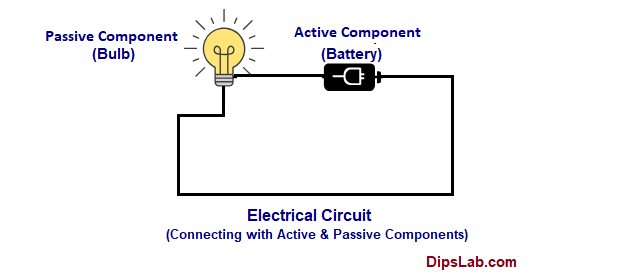
In our daily life, we see various types of electronic components such as bulbs, batteries, etc. These electronics components basically occur in sense of an active component or a passive component.
Before that we should know,
- What is an active component?
- What is a passive component?
So, in this tutorial, we will study what are the difference between active and passive components.
Let’s dive into the basics comparison with examples.
Active component vs Passive component
Both componets are compared based on the definition, working role, function, nature, use, example, and other specifications.
| # | Content | Active Component | Passive Component |
| 01 | Definition | A component that has its own capability to produce electrical energy in an electric circuit is called an Active component. | A component that has its own capability to consume electrical energy from other connected input sources is called a Passive component. |
| 02 | Working Role | The active component occurs in the form of a Power Source. | The passive component occurs in the form of a Load. |
| 03 | Electric Current | It has the ability to amplify, deliver, and control the flow of electrical current. | It has the ability to utilize, supply, and store the electrical current. |
| 04 | Function | The active component is always as Non-linear and Bilateral components. | The passive component is always as Linear and Unilateral components. |
| 05 | Electrical Energy | As per its working principle, it works as an electrical energy donor. | It works as an electrical energy acceptor. |
| 06 | Examples | Battery, Generator, Alternator, and other electronic components (LED, Diode, Transistor, Integrated circuit, Vacuum tube) are examples of the active components. | Transformer, Resistor, Switches, Voltmeter, Ammeter, Capacitor, and Inductor are some of the examples of the passive component. |
| 07 | Basic Function | The main function of the active device is able to generate energy in the form of current and voltage sources (like a battery). | The main function of the passive device is able to utilize energy in the form of current and voltage (like a bulb). |
| 08 | Electrical Power | External sources (such as a diode, transistor, resistance, and so on) are required to manipulate and to control the power in an electrical circuit. | It does not require external sources to manipulate and to control the power. |
09. Electrical Circuit Diagram
In an electrical and electronic circuit, both active and passive components are the most fundamental parts to make a complete circuit or active path.
Let’s see the given basic electric circuit that connected both components.

Note: In an electrical circuit, at least a single active component is required. Because, this active component (like a battery) generates energy in the form of voltage and current sources.
I have compared all the basic points to differentiate active and passive elements with the help of a circuit diagram. Hopefully, you can easily understand.
Related More Comparision:
- Alternating Current vs Direct Current
- Electrical Circuit vs Magnetic Circuit
- Series Circuit vs Parallel Circuit
- Resistance vs Reactance
- MCB vs MCCB
- Single Phase vs Three Phase
- Core Type Transformer vs Shell Type Transformer
If you have any queries related to the difference between active and passive components, you can ask me in the comment section below.
Thanks for Reading!
Battery is an active component and bulb which act as load passive component (require the enrgy to work)
Then what an electrical trsnaformer is?
A transformer is a passive component.
an active component is the one which act as a power source . transformer primary is a load on the power source while secondary act as voltage / power source for further load ckt. how ever as it does not produce power by itself and hence it is a passive component in electrical ckt as a whole .
Passive component
It looks somthing different
Thanks 🙂
Love this
Glad, you enjoyed it.
It was very informative. love your content. Thanks.
Thanks, you too, Muskan for your kind words.
I didn’t understand the diagram as you have stated above battery as an active component where as in diagram it shows battery as an passive component. same for electrical bulb too.
Thanks, Juned for commenting. I have corrected it.
Thanks, love your content .
You’re welcome, Nikita 🙂
Its very helpful.
Thanks.